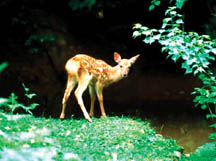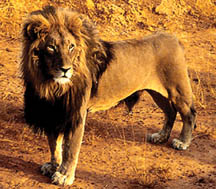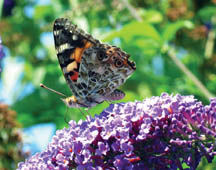
Natural habitats and nichés
  All living and non living things that affect an organism make up the
environment... Both plants and animals are living because they grow,
feed and reproduce to bring out a new generation of plants and animals.
They are part of what we call our natural environment. All living and non living things that affect an organism make up the
environment... Both plants and animals are living because they grow,
feed and reproduce to bring out a new generation of plants and animals.
They are part of what we call our natural environment.
We only have to look around us to see those living examples of nature
in the form of massive trees, colourful flowers, fields of grasses,
ferns or mosses, beautiful birds and butterflies, frogs, insects,
reptiles, mammals and many other creatures from the animal kingdom.
However, our environment is not made up of only living things but also
of non living things, some of which we cannot even see, such as the air
we breathe.
As living things depend on each other and on other non living things
for survival, it is essential to know more about our environment in
order to protect our own existence. Everything in the environment
affects the way an organism lives, and that includes us too. So, let's
check out more about the living things in the environment and what
habitats and niches mean, through Nature Trail...
  We all know that plants need light, air, soil and water to live,
while animals need food, air and water to survive. What is important to
keep in mind is that the multitude of these plants and animals that make
up our environment need their own special environment for them to
survive. For instance, if you take a closer look at a pond, river or any
other water body, you will realise that there are living things such as
fish, insects and plants in these water bodies that are visible to the
naked eyes. We all know that plants need light, air, soil and water to live,
while animals need food, air and water to survive. What is important to
keep in mind is that the multitude of these plants and animals that make
up our environment need their own special environment for them to
survive. For instance, if you take a closer look at a pond, river or any
other water body, you will realise that there are living things such as
fish, insects and plants in these water bodies that are visible to the
naked eyes.
However, there are some organisms in these water bodies that are not
visible, but are an essential part of the community of plants and
animals that live in those water bodies. It is similar in the sea,
forests, deserts, the polar regions or any other area where living
organisms are found. Each organism has its own environment.
The part of an environment where an organism lives is its habitat.
The word habitat is derived from the Latin word habere, which means to
have. Different species have the land as their habitat and the land has
the species as its inhabitants.
If we look at a forest, we can see that there are many habitats in
the forest. For instance, earthworms live in soil, birds and squirrels
live in trees, and reptiles have their own habitats. The place where an
organism lives or grows is its habitat and we need to protect the
natural habitats of all fauna and flora around us.
Even in these various habitats, each animal or plant has its own
niche (suitable place in life). Now what exactly is a niche? It is the
part an organism plays in its own environment. Every living thing in a
community has a niche. No two organisms have the same niche.
  For example, the earthworm we hardly pay attention to, except when we
want to dig it out as bait for fish perhaps, has its own niche; living
in the soil, digging its burrow by swallowing soil, feeding on bits of
leaves, seeds and decaying organisms in the soil, making tunnels in the
soil and so on. The niche includes where the organism lives, how it
lives and what it does. For example, the earthworm we hardly pay attention to, except when we
want to dig it out as bait for fish perhaps, has its own niche; living
in the soil, digging its burrow by swallowing soil, feeding on bits of
leaves, seeds and decaying organisms in the soil, making tunnels in the
soil and so on. The niche includes where the organism lives, how it
lives and what it does.
We little realise the harm and long-term damage we do to the
environment whenever we cut down trees, clear forest areas or pollute
waterways. The destruction of natural habitats such as wetlands, salt
marshes, meadows, the rainforests and other forests has not only caused
discomfort to animals living in such areas, but also succeeded in wiping
out entire species of plant and animal life as well.
Can we go on changing the natural habitats of animals and expect to
protect biodiversity? The answer is no. We have to pay more attention to
preserving the natural environment and the various habitats of animals,
if we want to be environment- friendly.
We need not go far to see the impact the destruction of natural
habitats has had on animals in particular, and us in general.
  The ongoing conflict between the majestic elephants, the biggest
mammals on land, and man in our country is evidence enough of the impact
our careless actions have had on the smooth functioning of our natural
environment. The ongoing conflict between the majestic elephants, the biggest
mammals on land, and man in our country is evidence enough of the impact
our careless actions have had on the smooth functioning of our natural
environment.
Cleaning of forest land for agricultural and development purposes
have led to the loss of animal habitats in many parts of the country,
and naturally, the large animals such as elephants have no choice but to
encroach into land which once was theirs and have now been taken over by
the people.
It is the responsibility of those clearing jungle areas for
development purposes to ensure that alternate habitats are provided, at
least for the bigger animals in such areas earmarked for development
projects; relocation of such animals is the ideal solution. But, who
really worries about the loss of natural habitats of animals in the
world today?
Perhaps just a handful of people, going by the vast destruction of
forest cover taking place globally. Learn about the various types of
natural habitats of animals and measures taken globally to help protect
them. Remember, the natural environment begins in your own garden!
|


